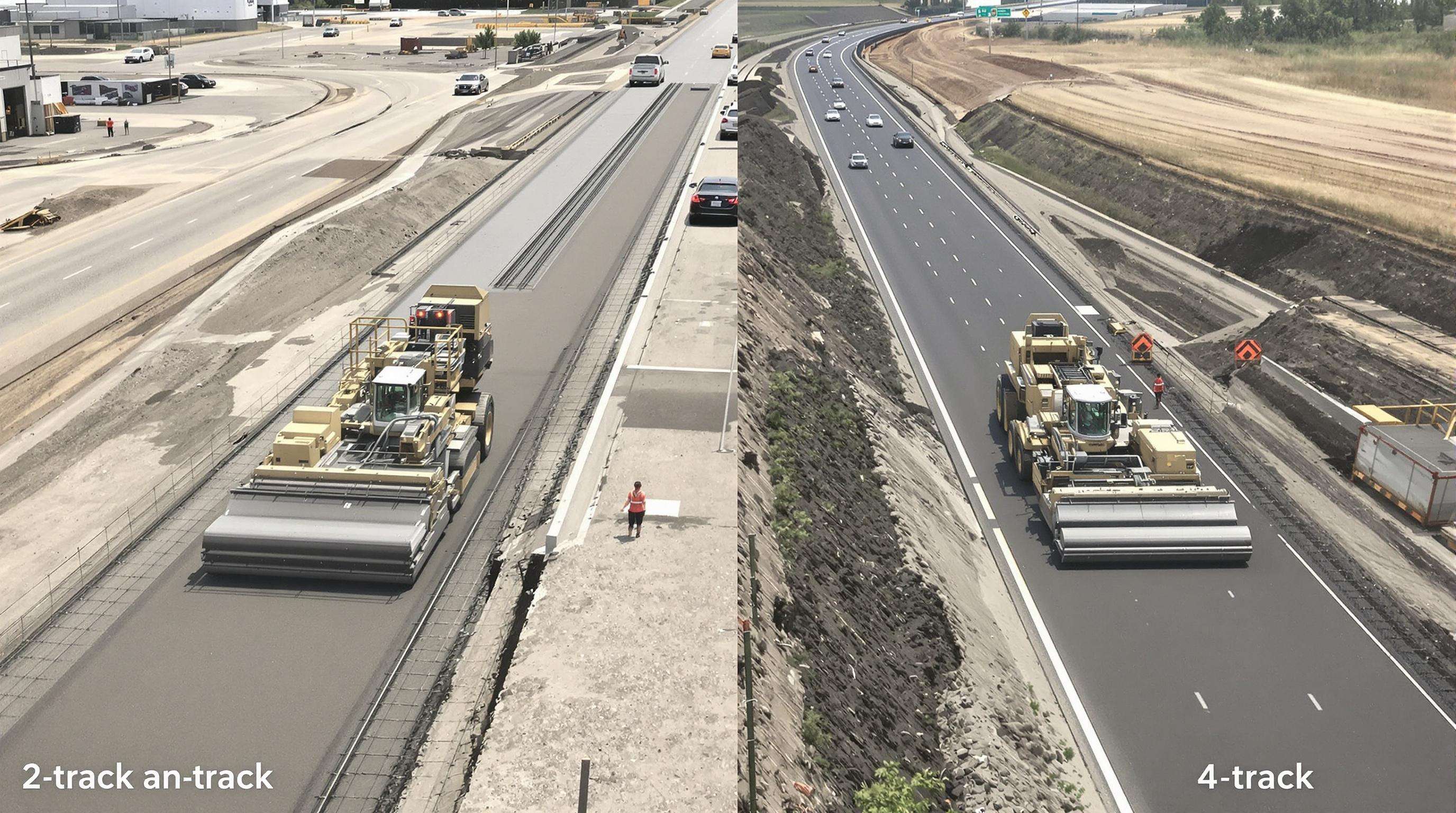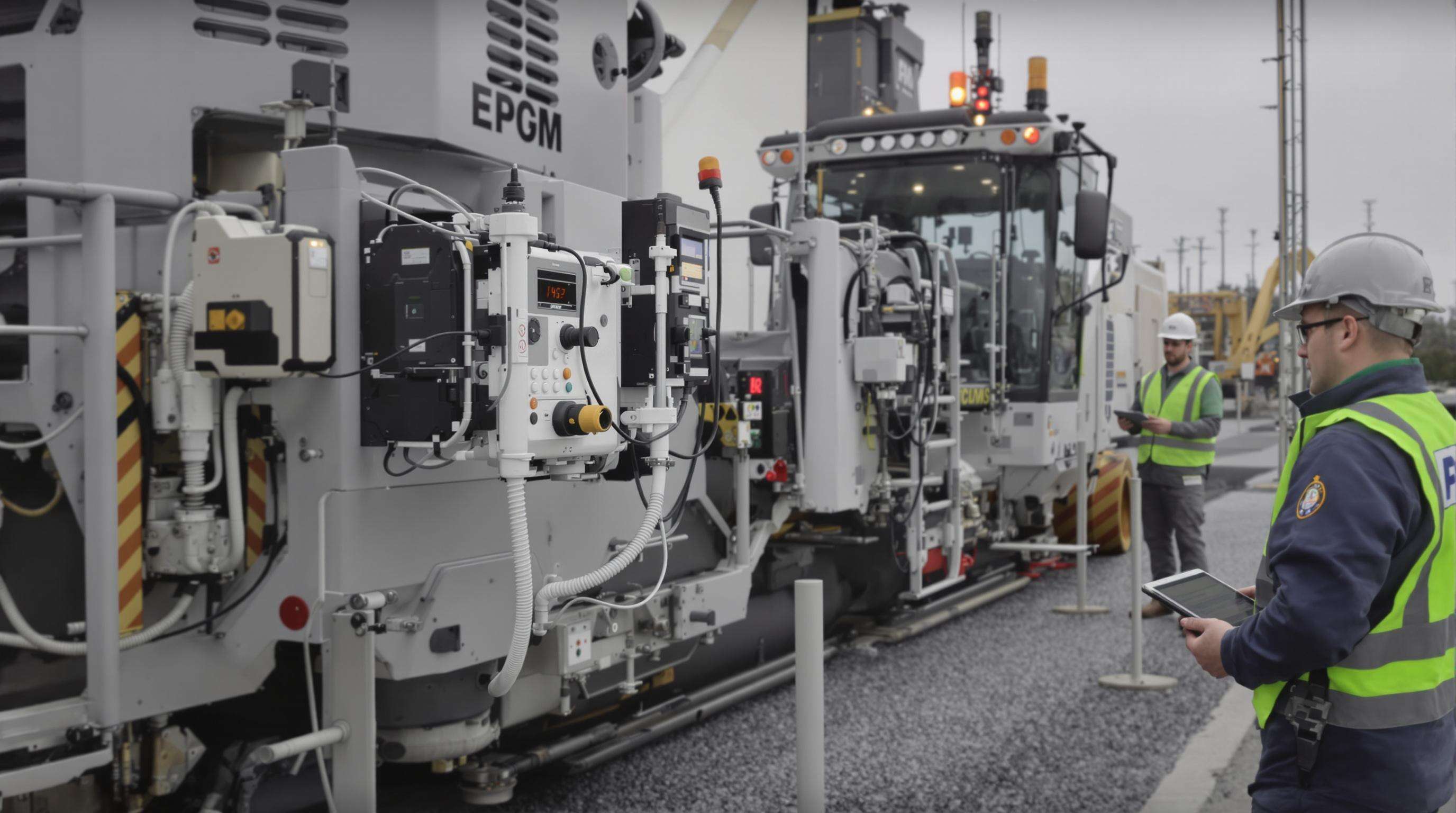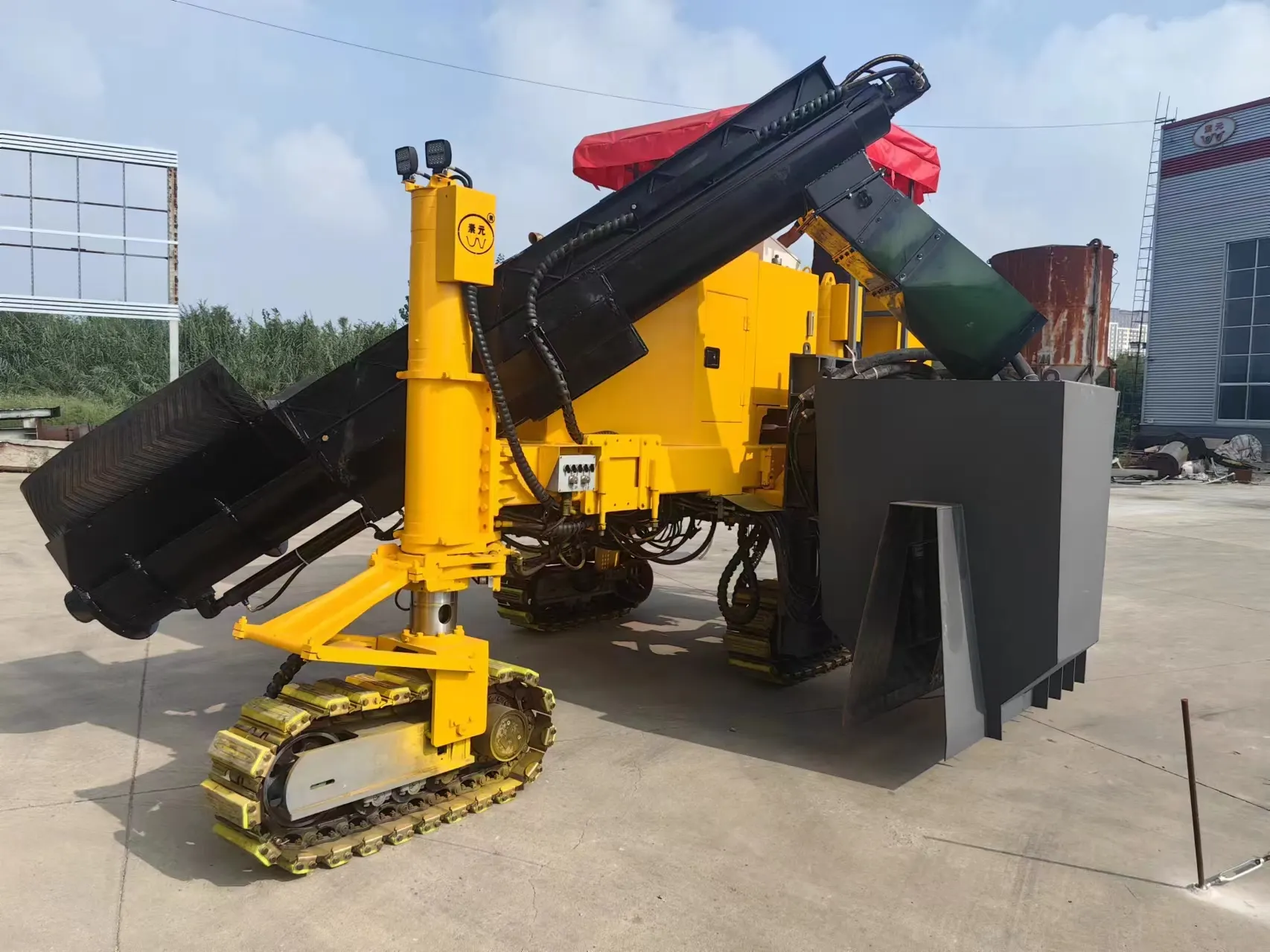Analyzing Project Requirements for Slipform Paver Machine Selection
Selecting an appropriate slipform paver machine starts by analyzing the project well. Concrete volume required dictates how much production capacity is needed – switch too light and you’ll be running to catch up, switch too heavy and you’ll waste precious cash. For example, an SM laying 350 m3/hr is fine for airport runways, but too inefficient for residential streets. Daily gross targets are in balance with machine capacities to avoid any bottlenecks.
Matching Machine Capacity to Concrete Volume Demands
Precisely calculate concrete consumption against paver throughput. High-volume projects like highways demand 400+ cubic meter/hour capacities, whereas urban roads require half that output. Factor in batching plant efficiency and transport logistics—any mismatch risks cold joints or excess material waste. Continuous pour requirements further determine minimum viable machine specifications.
Road Width Specifications and Paving Speed Calculations
The moving speed is directly related to road width and pavement quality. In the case of narrow roads (< 5m), single-pass paving can even be performed at a speed of 1 - 1.5 m/min, larger sections call for multi-pass procedures. Apply the formula: Pacing Rate = Project Duration · (Available Time - Setup/Curing Buffers). (Issue was edited to include the note that going faster than the manufacturer's speed rating may result in a rougher surface finish.)
Job Site Accessibility Constraints Analysis
Consider the points of entry on terrain, overhead clearances, and ground- bearing pressure. Restricted urban sites discriminate 2-track pavers with closed turning radii as opposed to highway being open jobs. The height of the machine can be limited by a bridge underpass and the soil may be unsuitable to support narrow track pads. Always map equipment haul—40% of all jobs have hitches involving unplanned mobilization.
2-Track vs 4-Track Slipform Paver Machine Classifications

Selecting the optimal slipform paver configuration critically impacts project execution efficiency. Both 2-track and 4-track systems serve distinct purposes, with track quantity influencing maneuverability, stability, and operational economy. Urban infrastructure upgrades often demand different solutions than rural highway expansions, requiring careful analysis of terrain constraints and output objectives.
Maneuverability Comparison for Urban vs Rural Projects
In an urban environment space can be limited, which 2-track plans are best suited for, as they are more compact and have a smaller turning radius. They can run between buildings, along existing utilities and in tight corridors with minimal inconvenience. On highway, the 4-track systems in contrast have a higher top speed (straight-line; open rural highway) but also have a wider operating clearance need. A typical city intersection project requires 40% shorter transition lengths than rural projects (Road Construction Quarterly 2023), so track layout is a significant consideration.
Stability Requirements for Highway Shoulder Paving
They're the most stable and excellent for vehicles with a tendency to lean at high speed, such as those using highway-shoulder applications - which are all 4-track. Four point contacting spreads out the weight evenly to keep pavers in the correct place on all pitched areas. This becomes important during the operation of external concrete vibrators when difference in forces causes less heavy machines to slide. Four-track versions show 30 percent less deviation on slopes greater than 8-degree angles (compared to national pavement association specifications) for consistent concrete compaction.
Stability Performance Comparison
| Factor | 2-Track Systems | 4-Track Systems |
|---|---|---|
| Maximum safe incline | 6° | 10° |
| Ground pressure | 15-18 PSI | 9-12 PSI |
| Shoulder paving width | Up to 5m | Up to 12m |
Fuel Efficiency vs Power Output Tradeoffs
Economic analysis of all other activities shows tradeoffs between consumption and power kg of capacity. LIGHTER 2 TRACK 15-25% savings on fuel (20-30 litres-per-hour) relating to the high load capacity but remain highly portable and easy to use across a variety of concrete volume applications. But 4-track options still provide enough hydraulic flowto do continuous pours on larger deck areas without additional help. For over 150 cubic meters of production per day, the increased productivity of the four-track machine typically pays for the fuel premium by a reduction in time on the project and possible labor saved.
Critical Slipform Paver Machine Specifications Breakdown
Effective concrete paving requires meticulous evaluation of three core technical specifications that directly impact project outcomes across diverse terrain and operational conditions.
Track Configuration Options for Uneven Terrain
Four-track systems distribute weight 38% more than two-track models (2023 Construction Equipment Stability Report), delivering outstanding performance in soft ground or on slopes of more than 10°. The articulated steering can provide 75% tighter turning radii than a rigid frame alternative (Twin and Travers) but operators pay 12-15% loss in average paving speed for increased maneuverability in tight jobsites. On chamfered axles and hard-packed surfaces, the twin-track configuration improves fuel efficiency by 25%, with good traction.
Screed Extension Capabilities for Variable Widths
With hydraulically adjustable screeds, width adjustments from 7.3m to 9.1m (24 ft to 30 ft) can be made in less than 15 minutes, with no need to change out components – a 92 percent decrease in time compared to fixed-width systems. Premium models offer automatic crown control which provides ±2mm rise accuracy throughout the full travel stroke. Contractors are experiencing up to 18% material savings on variable width projects when using extendable screeds versus traditional overlapping passes (2023 Highway Paving Efficiency Study).
Auxiliary Equipment Integration Possibilities
Modern pavers support simultaneous operation with:
- Concrete placers distributing 300 m³/hour over reinforcement grids
- Laser-guided curing machines applying surface retardants within 30 minutes of placement
- Compaction systems achieving 98% density ratios without separate roller passes
Integrated telematics platforms reduce idle times by 22% through real-time coordination of auxiliary units, according to 2024 paving automation research. Modular attachment points allow rapid reconfiguration between barrier curbing, flatwork, and slope paving modes.
Technology Integration in Modern Slipform Paver Machines

Modern slipform paver machines integrate advanced technologies to enhance precision, reduce labor costs, and ensure consistent quality in large-scale paving projects. These innovations address the growing demand for infrastructure projects with tighter tolerances and faster completion timelines.
Autopilot 2.0 System for Precision Grade Control
The Autopilot 2.0 takes the place of stringline setups, using GPS, LiDAR and sensors mounted on the machine to keep sub-millimeter accuracy during paving. This system is reducing human error by 47%, and gaining finishes to ±3mm grade no problems above or below 2% as reported in this 2024 Asphalt Paving Technology Report. Four free standing sensors check elevation every second and correct screed height automatically, while (patented) sensors keep the screed exactly at the right height in any corner. This technology is invaluable in runways of airports and decks of bridge where slight difference can lead to failure.
Stringless Paving Technology Cost-Benefit Analysis
Stringless paving reduces project setup time by 65% and labor costs by $18–$22 per linear meter compared to conventional methods. While initial implementation requires a $35k–$50k investment in 3D modeling and base stations, contractors typically recoup costs within 12–18 months on highway projects exceeding 5km.
| Cost Factor | Traditional Method | Stringless Technology |
|---|---|---|
| Setup Labor Hours | 120–150 | 40–50 |
| Material Waste | 8–12% | 3–5% |
| Re-Work Frequency | 1 incident/500m | 1 incident/2,500m |
The technology’s scalability makes it viable for both urban intersections and rural highway corridors.
Real-Time Monitoring Systems for Quality Assurance
' today's pavers use IoT-integrated sensors that monitor concrete temperature (accuracy ±0.5°C), vibration frequency (range 150-300 Hz) and moisture content (optimal 2.5-4%) during placement. These systems that detect undesirable conditions (e.g., cold joints, improper consolidation) and provide notice to operators thereto within 0.8 seconds so that a rapid response can be instituted. Project engineers tap in to centralised dashboards of compaction rate (98–102% density) and surface flatness index (±3mm/m tolerance) that simplify compilation of compliance documentation for DOT inspection.
Evaluating Slipform Paver Machine Service Support Networks
Global vs Local Dealer Service Response Times
Response times come at the project and its timeline, and directly reflect their status; global manufactures generally can provide between 48-72hr emergency organisation support due to their stock and distribution. Local resellers can sometimes offer same-day diagnosis, but often they are without the specialized expertise to repair complicated slipform systems. Manufacturers that provide mobile service units are a benefit when it comes to jobs in the back country, while dealers with on-call technicians are key for urban jobs. Some 67 percent of contractors see local spare parts availability as more important than brand reputation when selecting a service network, according to a 2023 study on the paving industry.
Warranty Coverage Comparison Across Manufacturers
Comprehensive warranties now span 3-5 years for critical components like hydraulic systems and augers, though coverage varies significantly. Leading manufacturers bundle extended warranties with predictive maintenance subscriptions, reducing unplanned downtime by 32% (ICPA 2024). Key comparison points include:
- Inclusion of wear items like mold liners
- Roadside assistance provisions
- Software/firmware update guarantees
Contractors should verify transferability clauses, as 41% of resale value depends on remaining warranty coverage.
Operator Training Program Availability
Certified training programs reduce paving defects by 40% (NCMA 2023), making hands-on instruction non-negotiable. Top-tier manufacturers provide:
- On-site machine familiarization (2-5 days)
- Troubleshooting simulations for common sensor errors
- Annual recertification for new technology adoption
The most effective programs combine VR-based grading exercises with real-world paving scenarios, enabling operators to master width adjustments and material flow control within 50 operational hours.
Frequently Asked Questions
What factors should be considered when selecting a slipform paver machine?
When selecting a slipform paver machine, project requirements such as concrete volume, road width, job site accessibility, project duration, and paving speed should be considered.
What are the advantages of a 2-track system over a 4-track system?
2-track systems offer better maneuverability, especially in urban environments with limited space due to their compact size and smaller turning radius.
How does technology integration improve the performance of slipform paver machines?
Modern slipform paver machines integrate advanced technologies like Autopilot 2.0 and IoT sensors to enhance precision, reduce labor costs, and ensure quality in paving projects.
Table of Contents
- Analyzing Project Requirements for Slipform Paver Machine Selection
- 2-Track vs 4-Track Slipform Paver Machine Classifications
- Critical Slipform Paver Machine Specifications Breakdown
- Technology Integration in Modern Slipform Paver Machines
- Evaluating Slipform Paver Machine Service Support Networks
- Frequently Asked Questions




